 June/July, 2013 - Vol. 27, No. 1.
June/July, 2013 - Vol. 27, No. 1.
 April/May, 2013 - Vol. 26, No. 6.
April/May, 2013 - Vol. 26, No. 6.
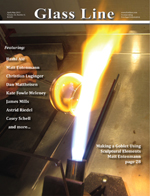 |
In This Issue
Flameworking with Opals by Bashi Alé
Before attempting to combine Gilson opals with my flameworked glass, I searched the Web for information. The common thread of advice was “put the opal in a tube and encase.” In reality, that’s all there is to it. It’s a straightforward process that can easily be explained with that one sentence. But I wanted more ... I like specifics, details. I like to hear tips from artists who’ve already undergone the trial-and-error process
...

My glass journey has given me the great opportunity to learn from amazing artists such as Andrea Guarino-Slemmons, Melanie Moertel, Suellen Fowler, and Michael Barley. The last class that I was fortunate enough to take, and my favorite thus far, was with Wesley Fleming. I have always had a fascination with and much love for all creatures. I have many glass spiders that I have collected through the years. Learning how to create them myself has be one of the funniest things I have ever learned. I like to use my bead skills for the bodies like this batik spider. I enjoy making them in whimsical colors that you would not necessarily would see in nature, like transparent purple spider.
Would you like to conquer your fear of spiders? There will be no need to be afraid of spiders anymore, since I am going to share a few tricks with you. I began making spiders after I took a class with renowned insect artist Wesley Fleming. My spiders reflect detail and techniques that I use in my beads
...

It looks so complex, but you will see just how nifty this technique is. I just love to get to the part where you pull and twist—it is so amazing that the spacing is so even and the mesh pattern appears like magic in front of your eyes!
This winged latticino twisty looks so cool on the edge of a bead, and that is why I have included step-by-step instructions for applying the twisty to a bead. Remember it is crucial to apply this neatly; keep the twisty evenly spaced and not pulled out of shape.
The Twisty looks great as decoration on any shape of bead, so let your imagination take flight with this “Winged” Latticino Twisty.
...

I have been making various seashell beads since 1994 and still enjoy the process of marbleizing the color and sculpting the shape, coaxing a good replica of a periwinkle shell from a custom-mixed gather of glass.
Start by making the barnacle cane. Adding several murrini cut from this cane to the outside of your finished seashell makes it look far more interesting
...

Wine glasses or goblets are definitely a test of skill for any glassblower, but they are one of my favorite things to make. You can incorporate so many different techniques into one object and it’s functional as well.
Making sure the bowl of the glass is on center and in proportion, and that the rim is symmetrical, is definitely challenging. One thing that helps is using the appropriate size tubing—it may be hard to pull points from 60 mm, but the rim comes out so much better than with 50 mm, because you do not have to change the shape nearly as much
...

As spring and Mother’s Day approach, I start to think about something I can make for my mom. It doesn’t have to be some elaborate piece, just something that will make my mother happy. I make my mother something for Mother’s Day every year that she proudly shows off to everyone all year long; that’s one measure of success for me, even though it isn’t monetary.
This year, I decided to make her a hummingbird feeder. In Oregon, where I live, we have several hummingbird species. Some are permanent residents and some migrate through every year. I’m lucky; several Anna’s hummingbirds frequent my feeders all year long. That gives me a great chance to try different styles of feeders, to see what they like and don’t like on an hourly basis. I have made and sold hummingbird feeders of different styles and I find this basic style to be easy to make. It can have a wide variety in color, size, and shape
...

Nearly 300 tendrils sprout from the 200-pound glass chandelier hanging from the ceiling of 575 Pizzeria in Amarillo, Texas. Transparent blue, green, lavender, and clear tentacles appear to swim through the air when the Panhandle wind blows through the front door of the upscale pizza parlor
...
Also: An example of Christian’s current work is this incalmo vase. The incalmo technique dates back to the 16th century, when Italian glassmakers wanted to make two or three different colored sections of glass look like one piece
...

With summer just around the corner, it’s time to dust off those lawn chairs, break out the sunglasses, and get a cold drink to sip in the backyard. But wait—we are missing something. We have our iced tea, but nothing to sip it with. Let’s change all that and make ourselves an Octo-straw. They are fun and easy to make, and everyone loves them
...
- Glassified Ads - April/May, 2013
- Vol.
26 No. 6.
- Workshop Calendar
|
 February/March, 2013 - Vol. 26, No. 5.
February/March, 2013 - Vol. 26, No. 5.
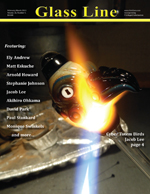 |
In This Issue
Cyber Totem Birds by Jacob Lee
Birds always come back into my sculpture—I keep having the urge to add beaks to things—so here’s how I make a basic bird head. I call these Cyber Totem Birds because they’re inspired by mixing a futuristic style with totem-pole art. I used Momka’s Cloud tubing for this piece. It’s a stable tan color, with interesting striations of green, blue, purple, and yellow. Cloud sort of turns clear, and then strikes back to the color you see. It’s a cool color in many ways ... try it out
...
Blowing Beads with Soft Glass by Monique Swinkels
I’ve been a lampworker for almost 10 years now and it’s still my passion. I love working with glass at the torch, discovering and combining several techniques, and exploring myself through the glass. It’s a wonderful journey that I enjoy every day!
Here is how I blow a bead with soft glass, using a handmade glass blow-pipe
...
Adventures in the Paragon Kiln Factory by Arnold Howard
It was 30 years ago that John Hohenshelt, Sr. bought Paragon Industries from Frances Darby, the company founder. As vice president of manufacturing for Tonka Toys, John was in his Mound, Minnesota, office when Frances phoned him unexpectedly.
“John, I’ve decided to sell you my company,” she said. “When can you come down here?” John was amused at her abrupt style. A few days later, he flew to Mesquite, Texas, and a few months after that, he owned the Paragon Kiln Factory
...

Matt Eskuche is an innovator whose relatively new body of work, “White Trash,” has gained attention not only within the glass community, but on the larger sculptural landscape. His glass groupings have edgy, provocative social themes, made explicit by titles such as “Tastes Like Applebees,” “Dude, Mom’s Going to be Pissed,” and of course, “White Trash.” These works evidence a high level of skill, dedication, energy, and creative independence
...
The Sleeved Mask by Ely Andrew
I dream about glass; I constantly think of color mixtures, shapes, or new possible techniques. I see a flower, I think, “Can I make that?” I see an odd shape or texture and think, “Can I do that?”
With that in mind, here is a sleeving technique I’d like to share with Glass Line readers. Here is a shot of my work station (image 1), I usually use 25 mm heavy wall tubing, but you can use whatever size you’d like. Fuming experience is required
...

The majority of the work I make is functional glass art. Hollow-forming glass has been the focus of my career. I reached a point where my work needed a more robust kick, so I started adding solid horns, small marbles, and other various bits, etc., to make what I thought were more comprehensive pieces. Venturing into entirely solid sculpture helped build my confidence in areas such as reheat times, making smooth connections between attachments, and building larger pieces in general. I hope some of these techniques will help in some way, shape, and form
...

When calling Mountain Glass Arts, you are greeted with a friendly person ready to help with your questions and order. Upon entering the warehouse, your first reaction will most likely be excitement about all the glass surrounding you. You will notice activity on the sales floor, orders being pulled and packed, new product coming in, and the phones ringing steadily. Has it always been this way?
...
A Bead with a Three-Dimensional Rose by Akihiro Ohkama
In this demo two types of torches--with a focused flame and with a diffused flame--are used according to which is best for the job
...
- Glassified Ads - February/March, 2013
- Vol.
26 No. 5.
- Workshop Calendar
|
 December/January, 2012/13 - Vol. 26, No. 4.
December/January, 2012/13 - Vol. 26, No. 4.
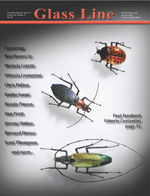
|
In This Issue

The Vortex Marble has been a mainstay of marble-makers and glass workers for many years. Its fascination for most people is the illusion of spiraling down into a chasm that seems to go deeper or further than they believe possible. The colors, amount of sparkle, number of turns, and depth seem to affect each person differently. Some love the straight shot down with lots of depth, while others love a curve out of view at the bottom. There is also something about the shape of the sphere that attracts us. In a way, each marble is its own self-contained world, worthy of many years of enjoyment and exploration.
As I said in a previous article (“Making Deep-well Marbles,” Glass Line, Aug./Sept. 2011), I have been doing glass for approximately 12 years and seriously producing marbles for the last six years or so. When I made my first marble, I was hooked. I don’t know what it is but I love the shape, focal containment, and individuality of each piece. Not to sound too corny, but each one stands alone like a planet, vision, or alternate reality. We are optical creatures and we love the optical illusion or trick — consider the popularity of magicians or the mystique of a mirage...

There once was a jewelry designer who really liked beads. She used to string pretty stones and silver together. Then one day she discovered hand made glass beads and began her descent into glassy madness. Time passed while she toiled on rented torches (she still toils on rented torches). She spent several years trying to find a glass voice taking classes with well known lampworkers and torching for a few hours one day a week. She searched and searched all the while coveting the skills and renown of other glass artists. One day not too long ago she took a class with Kimberly Jo Affleck (kimberlyaffleck.com) and read the article Shocking Pink Beads by Miriam Steger-van der Schrieck (facet-design.nl) It was this class and tutorial that introduced her to the super powers of Clio. And thus began her new life mission of putting Clio on everything including cocoa puffs.
In reality I took a class with Kimberly Affleck in December of 2011. After that I happen to read the Shocking Pink Bead article and took a class with Hayley Tsang Sather around January/February of 2012. I was fascinated with the brilliant fuchsia color from the tutorial and started spending all my torch sessions attempting to achieve it. It took a several months to learn how NOT to overheat the double helix to get vibrant colors with or without pearly streaks. At that point I started experimenting with Orange Translucent Special
(422-T) vs. the Striking Orange (072) I had been using and created the most gorgeous peach color I had ever seen. I
had some more aha moments and started applying the layers of Clio onto ink blue, aqua, violet, red etc. to see what color combinations I could achieve and what types of color reactions I could get. I have spent the past 10 months experimenting with Clio color reactions
...

The Pineapple Mold Technique always amazed me as I would watch hot-shop glassblowers create sculptures and vessels with this beautiful, intense, symmetrical pattern of air dots. I had to try this technique on the torch. I asked myself, “How am I gonna trap that pattern without a furnace of molten glass to dip into?” After some experimenting, I figured it out, but I wanted the technique to evolve — I wanted the pattern to be unique to lampworking borosilicate glass. I started playing around with it for awhile by using different colors and even frits and powders. Finally, I decided to use silver and gold fume in the process and that was it! This pattern really caught my eye of creativity
...

Until recently, my work mostly used solid rod to create pendants and marbles. Over the past year or so, I have expanded to working with tubing and now use it as much as possible. I love the effects that can be achieved, not to mention the challenge of tubing itself. In exploring different uses for it, I have been trying to learn how to create a lens for a marble with tubing, which led to the technique in this tutorial. This technique allows me to encase a design without distorting the pattern. I can then add a thicker lens to magnify the design, or leave it as is
...

It seems as though, over the last 20 years or so, we have been trying to re-create glass in its basic form. With all the techniques that have evolved in the borosilicate world, we have completely changed how we see glass. The fuming, wig-wags, implosions, condensing ratticellos, amber purples, sparkle layering, frits, powders, reductions, dichroics, electroplating, colors after colors, all both enhance and take the “glassiness” out of the glass.
Don’t get me wrong – I use and enjoy all these techniques and applications to make glass more interesting, as well as to find ways to apply these techniques to diversify and expand design and artistic possibilities. Instead of using these colors and applications to better a design, though, I sometimes tend to design around them. I’ll ask myself, “What can I make in Unobtainium or Alien Tech that would use that color best,” or “I really want to cover something in a reduction powder today; what can I do?” or ”Can I put too many different tricks into one piece, making it a carnival of trickiness?” Ahhh ... !
...

At age 19, Vittorio Costantini bought a lampworking torch and an illustrated book about insects with the idea of someday earning his own livelihood by making insects in glass. While lampworking was new to him, Vittorio was already a seasoned glassworker. At age 11, he got his first job as an apprentice in one of Murano’s glass factories. By 19, he had moved up the ranks in several glass factories and mastered a variety of furnace-working techniques
...

The change from furnace work to flamework came gradually, although I played with making beads, marbles and other small objects in the flame right from the beginning. However, there was no ready market for these objects in Australia in the 1980s, so they were not my main focus. It was not until I bought a Lucio Bubacco video that I realized the possibilities; I watched Lucio form a beautiful figure from soft Italian glass and join it to a foot and bowl to make a goblet, and I went straight out to the studio and made a figure, then a spider and then a beetle. This technique of not going back except onto small, thin ends was a revelation, as was not having to rush the work into a kiln when finished.
Of course, the desire to work with borosilicate glass came next, its wonderful changing colors and resistance to thermal shock a large part of its appeal. I adapted the Italian way of working with borosilicate with a few changes, and learned to create animals, insects, fish and figures in this wonderful glass. One of the benefits of being isolated from the rest of the glass world is that you develop your own style and techniques, which make your work different from that of other people working in the same medium.
In the mid 1990s, I taught glass studies at the University of South Australia for three years and discovered the joys of passing on knowledge and skill to others. I still have contact with some of the students who were in my classes, some of whom have gone on to full-time careers in glass and I am still invited to teach workshops in both soft and hard glass around the country. During these workshops, I show how I make my work, usually with simple things that can be put together from premade components on the bench.
The little frog in Persimmon Strike is one such example; the legs were premade as was the eye cane, and the body was built at the bench with the limbs joined on using a system of bridges to help with achieving well-fused joins. After I built the frog, it sat on the bench until later that evening, when it was annealed to relieve stresses and develop its full color
...

When the leaves start to change color and the temperature starts to drop, it is nature’s reminder for me to start thinking about making holiday ornaments. Each year, I tell myself to start making them in October. When Thanksgiving weekend comes around, many people start putting their trees up and begin decorating. From that moment until Christmas Day, ornaments are a hot item for glass artists.
Traditionally, the equipment required for blowing glass ornaments made it cost-prohibitive for a hobbyist to join in on the fun. With pre-made ornament blanks, that has all changed. With a $40 torch connected to a $10 Mapp gas canister, anyone can make their own gorgeous glass wonders. These blanks cost less than $1.50 each; even with the addition of colored glass and a fancy silver cap, the cost will stay around $2 per ornament.
The sparkle of dichroic glass is always a nice touch for a holiday-theme glass art piece. Coating by Sandburg (CBS) makes dichroic flakes in 90 COE, which matches these ornament blanks perfectly. How about a white glitter ornament that glows when the lights are turned out? Glow-in-the-dark glass has been available for a few years now, but only a few sources make a quality product that is compatible with this style of ornament.
Each year, I try to come up with something new. Joe Imler, founder of Glow Glass LLC, was visiting recently while I was working on my new ornament design for the season. My 2012 ornament design demonstrates the influence of the new dichroic flakes from CBS and the glow-in-the-dark powder from Glow Glass
...

This tutorial will demonstrate the making of Japanese Lampworked Buttons.
You can make original buttons using various murrine. Why don’t you try it?
...
Fire It Up! 2012 – Event Brings Glassworking to Youth
“Bridging The Gap” - by Dan Pratt.
The Great Lakes Art Society got things fired up for Water Street Glassworks this past September, by kicking off its school year with a fundraising collaboration event. Water Street Glassworks is home to the Fired Up! Program, an afterschool 501(c)(3) nonprofit organization that teaches art glass techniques and business management to adolescents. The society hand-selected the Fired Up! program as recipients of its premiere fundraising collaboration event due to the many positive and growing opportunities the program offers the youth of Benton Harbor, Michigan, one of the nation’s most poverty-stricken communities
...
- Glassified Ads - December/January, 2012/13
- Vol.
26, No. 4.
- Workshop Calendar
|
 October/November, 2012 - Vol. 26, No. 3.
October/November, 2012 - Vol. 26, No. 3.
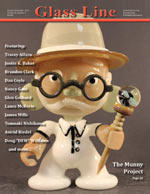
|
In This Issue
A Wigwag Cane - by Astrid Riedel.
This year, I found myself influenced by techniques used in marble-making and glassblowing. The challenge is to bring it down into the miniature glass world of beadmaking and find ways to make it work. Out of this effort has come my 3D techniques, which I use in both lentil and hollow beads...

This pinwheel flower glass wine stopper is a great project for home use, gifts, and sales.
Justin Baker melts glass at Cornbread Studios at his home in Shreveport, Louisiana. He started lampworking in early 2010 and has been in love with it ever since, although his love for glass has been a lifelong passion. It took years of observing and being mesmerized by glass to finally take the plunge and try making beads. After his first bead, a green-and-gold soft-glass bead to pay homage to his high school, the hook was set and there was no getting away from glass. After a short run with soft glass, Justin discovered borosilicate glass and loves the highly reactive colors available from various manufacturers. Most of his influences come from everyday living, from passing a billboard to viewing modern art; all can inspire a new color palette or new design...

Reticello marbles can be made with any number of lines on pretty much any size tubing, as long as it isn’t too small in diameter. This particular style of Reticello uses a 64-line “retti” on a section of 25.4 mm heavy wall Simax tubing. You may use whatever size blowtube you are comfortable with; I tend to use 9.5 mm or 12 mm heavy wall...

Boss Tubes is a glass company out of the Chicagoland area, found and run by two brothers, Scott and Brandon Clark. Scott has been in the glass industry for nearly 15 years. He has taken multiple classes at Penland School of Crafts, and had the opportunity to work with many great artists over the years. Brandon has been in and out of the shop over those 15 years, but just recently started working behind the torch full-time in November 2011. Recently added to the team is Morgan Virag, who studied soft glass for four years at Fresno State University and has another four years’ experience working with scientific glass. All are avid and enthusiastic artists, aiming to produce the highest-quality, affordable, and most-functional glass art! We love what we do, and we hope you get a chance to enjoy our glass as much as we do!
An implosion dish is a great project to consider. Here is how we make one at Boss Tubes...

In this tutorial I will demonstrate the making of a silver foil cane and a bead decorated with it...
Functional Art - by Glen Gothard.
It was no surprise that, when a customer asked me to make a piece of functional art to hold ashes of a loved one, my creative side took a giant leap toward the piece that this article is about. The piece has facets of both functionality and creativity. Use your imagination and enjoy!
...
Encalmo Reversal Ashtray - by Lance McRorie of FlameTree Glass.
Ashtrays make interesting projects as glass art. This one results in a colorful wigwag design using encalmo reversal.
Lance McRorie is owner and operator of FlameTree Glass, Inc., in Historic Roswell, Georgia. FlameTree has a glass art gallery and state-of-the-art teaching studio and sells lampworking supplies. McRorie is the primary instructor at the FlameTree studio. He is a well-rounded flameworker, with talents ranging from sculpting soft glass to blowing intricate borosilicate goblets...

It is unlikely not to have heard or read about the Art Glass Invitational (AGI) before now. After all, 2012 was the 12th year of this event. I am a relative rookie (two years attending) at AGI compared to some, but I came away with a great experience of learning from those who provided us with informative and fascinating demos, both formal sessions by scheduled presenters and impromptu ones by other attendees. I also know that I have made friends for life...
Cremation Art - by James Mills.
Through the process of making cremation art, I get a unique chance to touch the lives of each and every soul that entrusts their loved ones to me. In turn, I am touched and forever changed by each soul that passes through my hands and into my art. Handling someone’s ashes is as delicate a process as communicating with the loved ones...
Home for the Holidays - by Nancy Gant.
We all love to go home for the holidays. It brings back the childhood dreams of family, hugs, and special treats. Remember the smell of gingerbread cookies and holiday ham cooking in the kitchen? I love watching the reactions to my holiday beads; they warm the hearts, and bring back such good memories. First people smile, then they giggle and say, "Oh, look, a gingerbread man—I remember those!" I can tell when these little charms take people home for the holidays, at least for a moment.
Let me walk you through this simple bead; it will unlock the world of miniature bead sculpture...

Dan Coyle’s collaborative Munny collection offers a fascinating view of the phenomenon that is glass pipe art. Each one tells a unique story about the respective artist and his or her style, and the pipe function of the pieces is hardly a focus at all. In fact, viewers might not even realize that the Munnys were pipes if they didn’t know better. The detailed craftsmanship of the Munnys speaks for itself when it comes to artistic credit for their creators. These little glass creations are quickly becoming highly sought-after by art collectors, and they keep getting more creative. The father of glass Munnys has some interesting things to say about how he sees the glass art world...
- Glassified Ads - October/November, 2012
- Vol.
26, No. 3.
- Workshop Calendar
|
 August/September, 2012 - Vol. 26, No. 2.
August/September, 2012 - Vol. 26, No. 2.
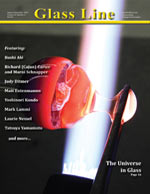 |
In This Issue
Flameworked Implosion Paperweights Demo,
by Bashi Alé.
Glass paperweights have been revered and collected since the 1840s. French craftsmen made elaborate paperweights to adorn the desks of the wealthy. Today, these beautiful works of glass art can be found in some of the most prestigious museums in the world.
More than knick-knacks, glass paperweights are considered fine art. They are challenging to make and require a substantial amount of time, sweat, and materials to craft.
This step-by-step tutorial shows how to create a silver- and gold-fumed implosion paperweight with a clover frit background
...

Although this pendant has iridescent dazzle like dichroic glass, it is not made of dichroic glass, borosilicate glass, or Moretti. It is made of Satake and silver foil. You can do this without using an oxygen burner. Since this is by Tatsuya Yamamoto, a lampwork expert who knows inside out of Japanese glass, it is designed to be practical as well as sturdy
...

Space has always intrigued me as a topic. The infinite nature of the Universe and all its wonders and complexity are make it so alluring. Trying to replicate a galaxy or an entire universe in glass comes with a unique set of challenges. Starting out, the goal is to create a large marble (globe, orb) with enough depth to represent the universe. This is a difficult task, because the amount of sparkle needed to create it has to be layered in a way that it starts out soft and becomes denser toward the back of the object. Another challenge is creating some interesting objects in the foreground. Their position automatically makes them a focal point, or even the topic of the art piece, so the techniques have to be clean enough to hold up to the task.
As part of my glass series, I covered techniques for shaping marbles in detail in “The Cane Marble” (April/May 2012, Vol. 25, No. 6), and “Sharing the secret to beautiful marbles” (December/January 2009/10, Vol. 23, No. 4). This is a continuation of the series ...

Glass has endless potential, and plant sculptures are an area in which borosilicate seems to be a natural medium. In making this sculpture, I was reminded of just how much fun and rewarding creating a plant sculpture can be. Another aspect that I really like about making plant/floral sculptures is they can be very free-form. For example a shark, dolphin, or whale has a set number of fins in specific locations, but a plant can have any number of leaves, flowers, and stems in any combination of locations on the sculpture. You do have to be mindful not to make a flower too symmetrical or it will not look natural. Experiment and have fun with it!
...

High Volume Oxygen, a new company on the glass scene, made its debut at the American Glass Expo and at the Glass Craft and Bead Expo in Las Vegas, where its oxygen control and compression system powered demos by, among others, Eusheen Goines, Lewis Wilson, and Milon Townsend.
Marc Kornbluh and Eric Ellenwood of Lincoln, Nebraska, started the company in 2011. Using large oxygen tanks, oxygen-rated equipment, and a digital control system, the High Volume (HV) Oxygen systems capture and compress the oxygen produced by oxygen machines like the ones made by Sequal and OGSI. With a bank of two to six oxygen machines, the HV systems can produce enough oxygen to power any torch.
...
Making a UV Stuffed Shell,
by Richard (Cajun) Carter and Marni Schnapper.
We made this piece together and thought Glass Line readers might enjoy seeing how such a team project works. The first steps cover making an implosion
...
The beginnings of a career in glass,
by Yoshinori Kondo.
How did I start my glass career? That’s a good question. If this helps to encourage another individual on this planet to be a new glass artist or client, then I consider my time and this Glass Line issue worth a million
...

This article explains the step by step process of making one of my favorite product lines, Day of the Dead (Dia de los Muertos) Jars. These little skulls or “Calaveras” are a creative reflection of my interest in the Mexican celebration of el Dia de los Muertos.
I was hesitant about making these and even more so to write an article about the process, due to the over-popularity of this image in mainstream culture today. It seems like everywhere you look, from t-shirts to tattoos, the Day of the Dead skull image has become very trendy in American pop culture. However, on a recent trip to various parts of Mexico, I was fortunate to experience the traditions of the festive event first-hand, and it left a lasting impression on me that inevitably found its way into my artwork. I remember walking into a local panaderia in Durango, Mexico, and seeing all of the vibrant, colorful sugar skulls and Pan de muerto, and saying to my wife, “This would be a great design to make out of glass!”
Low and behold, here it is: a fun, easy, and unique product line for all to enjoy!
...

A long and winding metaphorical road, as well as the actual twisting roads of rural Pennsylvania, led me to an amazing little conference at the Glass Blowing Center near Hilliards in May—the Soft Glass Invitational (SGI) of 2012
...

I was on a quest to find an easy way to achieve the sensuous form of the curved bead. Bending brass mandrels was easy; removing them from the mandrel, not so easy. The lower melting point of brass also became evident when, more than once, a beautiful bead spontaneously dropped to the table.
I recalled seeing an enameled copper tube bead demo in the late ’90s and wondered, “Would copper tubing work as a mandrel/sleeve for glass rod?”
Copper enameled beads are made by rolling a heated section of tube over enamels that have a wide range of expansion and are suitable on a copper substrate, but glass rod is another matter, with less tolerance of expansion differentials. After some experimenting, I’ve come up with a successful technique that I will share with you in this two-part intermediate-level tutorial that also demonstrates how to stir glass with a tungsten pick. It can be such fun, but prepare for some failures as you practice the riveting—make your first ones simple
...

We started this series of curving the bead axis with Leslie Thiel’s ceramic sleeve technique in Glass Line (Dec./Jan., Vol. 25, No. 4). Recently, I was invited to demonstrate at a studio that didn’t have any dies to bend the bead around. I wondered if a die was needed at all—and the answer is no. Die-less bending is advantageous not only because you can delete the die from the tools you need, but because it also eliminates the problem of bending too hot and flattening the inside curve that is pressed against the die. However, there is still the potential to curve unevenly, so make sure the bead is evenly heated
...

For young artists, watching a master create works of art right before their eyes can spark a flame that takes their own potential beyond anything they ever believed possible.
At Salem Community College (SCC) in Carneys Point, New Jersey, hundreds of glass artists, including SCC students, have learned from the authorities in the field through workshops, live demonstrations, and expert roundtable sessions during the International Flameworking Conference.
Held every spring since 2001, the International Flameworking Conference celebrates excellence in glass while hosting renowned glass artists who offer insight, instruction, and inspiration.
...

The 18th Annual Glass Craft & Bead Expo filled the South Point Hotel Casino in Las Vegas, Nevada, from March 28–April 1, with nearly 1,000 students enjoying 250 classes presented by 72 of the top instructors in their fields and 8,977 people attending the show floor, which featured 130 exhibiting companies in 62,000 square feet of space at the South Point Hotel Conference Center and Exhibit Hall. The student population came from Australia, UK, Mexico, Sweden, New Zealand, nine provinces of Canada, and 45 U.S. states as well as the District of Columbia and Puerto Rico
...
|
 June/July, 2012 - Vol. 26, No. 1.
June/July, 2012 - Vol. 26, No. 1.
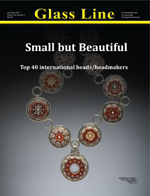
|
Special Edition:
Small but Beautiful
Top 40 international beads/beadmakers:
Affleck, Kimberly
Ahles, Dolly
Barrett, Beau
Bowker, Laura L.
Cahill, Patti
Carlson, Deborah
Edwards, Kim
Fairclough, Becky
Fields, Kim
Fleming, Kate Rothra
Frantzen Orr, Kristen
Fuga, Alessia
Fuhr, Kerri
Genack, Patti Leota
Hattori, Ayako
Heilman, Bronwen
Kihara, Noriko
Knapp-Tyner, Beth
Kondo, Naomi
LaGrand, Sara Sally (Juror)
Liu, Robert K. (Juror)
Logan, Kristina
|
Mangiafico, Michael
McDonagh, Fahan Sky
Moertel, Melanie
Moore, Gail Crosman
Munshower, Joy
Peacock, Janice
Schmidt, Terri Caspary
Seymour, Art
Shiroshita, Ayuko
Simon, Barbara Becker (Juror)
Stankard, Paul (Juror)
Strauss, Elise
Tajika, Yumi
Taniguchi, Chieko
Tanoue, Emiko
Tischler, Andrew
Todd, Belinda
Uchida, Toshiki
Wadsworth, Katherine
Waldman-Smith, Amy
Zinser, Margaret
|
Glass Line magazine recently invited Sara Sally LaGrand, Barbara Becker Simon, Paul Stankard (all practicing glass artists) and Robert K. Liu, PhD to jury its 2012 “Small but Beautiful” international competition for flameworked glass beads, to both capture the status of this artform at this time in the 21st century and mark its 25 years of publishing.
As an illustration of the global reach and appeal of flameworked beads, the 103 entries were from 10 countries — Canada, Italy, England, Germany, the Netherlands, Japan, Australia, New Zealand, South Africa, and the United States — and the top 40 entries came from the United States, Canada, Italy, England, Germany, and Japan.
Don’t miss seeing colleagues’ inspirational work!
|
|
 April/May, 2012 - Vol. 25, No. 6.
April/May, 2012 - Vol. 25, No. 6.
|

